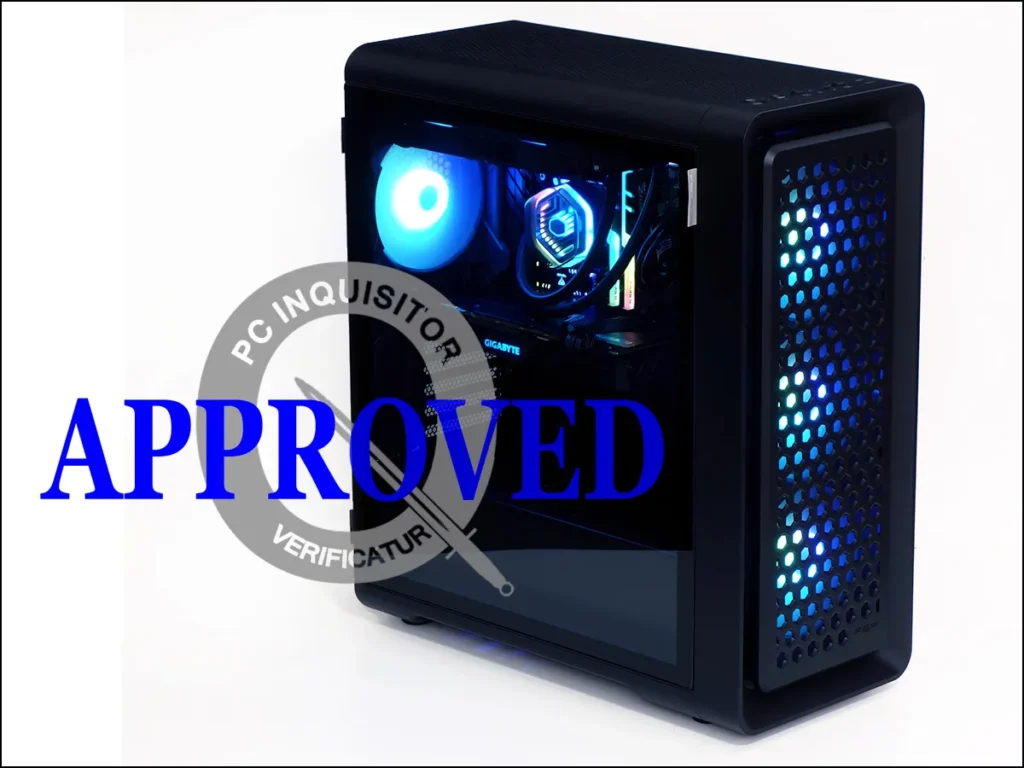FSP CUT593 Extended ATX Mid Tower Gaming Case Review
Those of us who have been around for a while remember when a company called Fortron/Source Powerman became famous for making reliable power supplies that didn’t cost a lot of money. Today’s FSP Group is still doing that for the OEM and white box market while adding only with a little extra flare to its consumer-facing products. We weren’t too surprised when the company came to us a couple years ago hoping to make the same play in the case market, and today’s model hopes to impress us with lessons the company learned from previous products.
| FSP CUT593A | |||
| Type | Mid Tower | Included Fans | (3) 140mm Front, (1) 140mm Rear, all ARGB |
| Motherboard Support | EATX, ATX, Micro ATX, Mini ITX | Front Fan Mounts | (3) 140mm / 120mm |
| Dimensions (HxWxD) | 21.5″ x 9.05″ x 19.6″ (54.5 x 23.0 x 49.8 cm) | Rear Fan Mounts | (1) 140mm / 120mm |
| Weight | 18.7 lbs (8.48 kg) | Top Fan Mounts | (3) 120mm or (2) 140mm |
| Max Motherboard Depth | 16.75″ (42.5 cm) | Bottom Fan Mounts | X |
| Card Length | 425mm | Side Fan Mounts | X |
| Power Supply Format | PS/2: Max Depth 230mm | Top Rad. Clearance | 52mm vertical, 44mm horizontal (max) |
| Air Cooler Clearance | 175mm | Front Rad. Clearance | 60mm |
| External Bays | X | Front Filter | Nylon Mesh (magnetic frame) |
| Internal Bays | (4) 2.5″, (3) 3.5″ | Top Filter | Nylon mesh (captured) |
| Card Slots | 7 | Bottom Filter | Nylon mesh (slide-out) |
| Ports/Jacks | (1) Gen2 Type-C, (2) Gen1 Type A, Headphone, Microphone | Damping | None |
| Other | X | Price | $90 |
Find it at Amazon

(click for availability)
Big changes include a ventilated front panel for increased airflow and a hinged side panel for easier access, compared to the screw-on glass surround of it previously reviewed CMT510. It also has a much more plastic aesthetic with its pop-out front dust filter and rounded top and bottom corners, all framed in the material. The quality fit and finish still keep it firmly within the middle market for which its priced.

Metallic coverings on the power and reset buttons spruce up the front plastic a bit along its top edge, and the addition of rubber plug on all ports adds a higher level of dust protection than…nearly anyone. The problem is that you’ll have to remove those plugs to use the ports/jacks, and then you might just lose those useful plugs.
Two Gen1 Type A and one Gen2x2 Type-C port address USB3 needs, while separate headphone and microphone jacks address headset needs. The two things not labeled are view holes for the power and drive activity LEDs, which are located beneath the plastic.
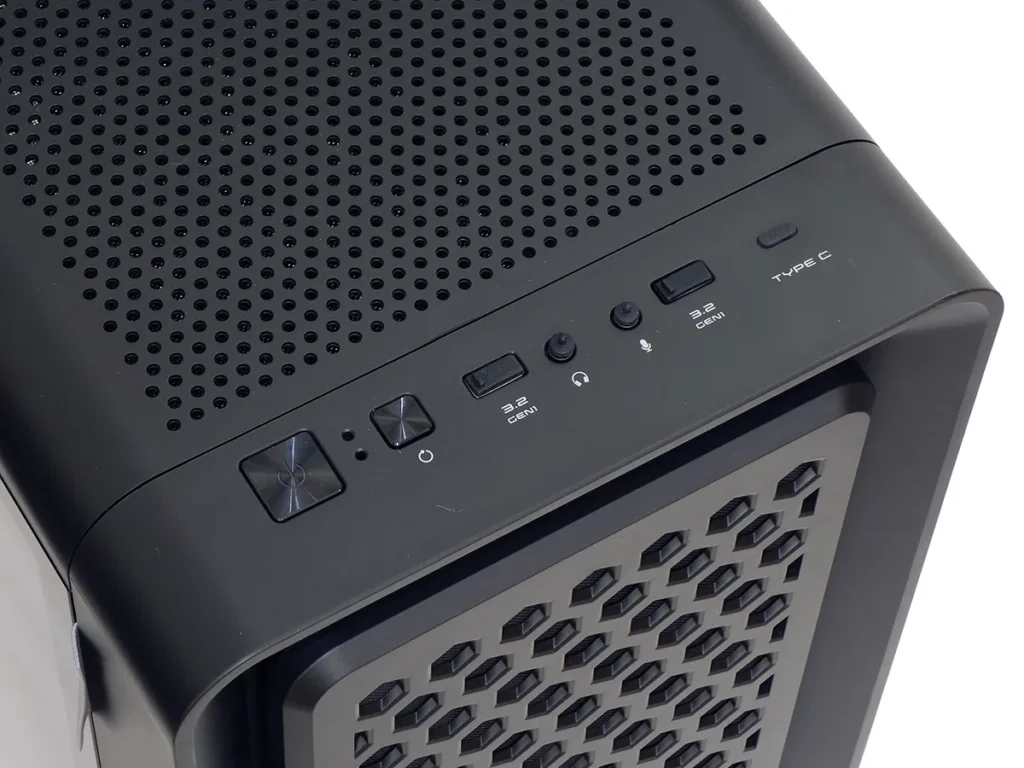
A single thumb screw secures the plastic top panel to the CUT593’s rear panel, where removing that screw allows the top to slide back and be lifted off. The rest of the back panel is a flat sheet, fancy enough to use replaceable (screwed in) slot covers rather than disposable knock-outs, but still cheap enough to use a folded-out tab for card or slot screws, rather than a framed-in I/O section.

The typical problem with folding the card tab out of the case is that inserting the tab through the access slot can sometimes be difficult, but FSP solved that by making its slot four times as wide as it needed to be. The firm also added a slide out dust filter for the power supply air inlet, just to prove that it’s putting its manufacturing budget into features that users will appreciate.
Notice the hinges for the glass side panel: Swinging it open allows the panel to be lifted off its hinge pins.
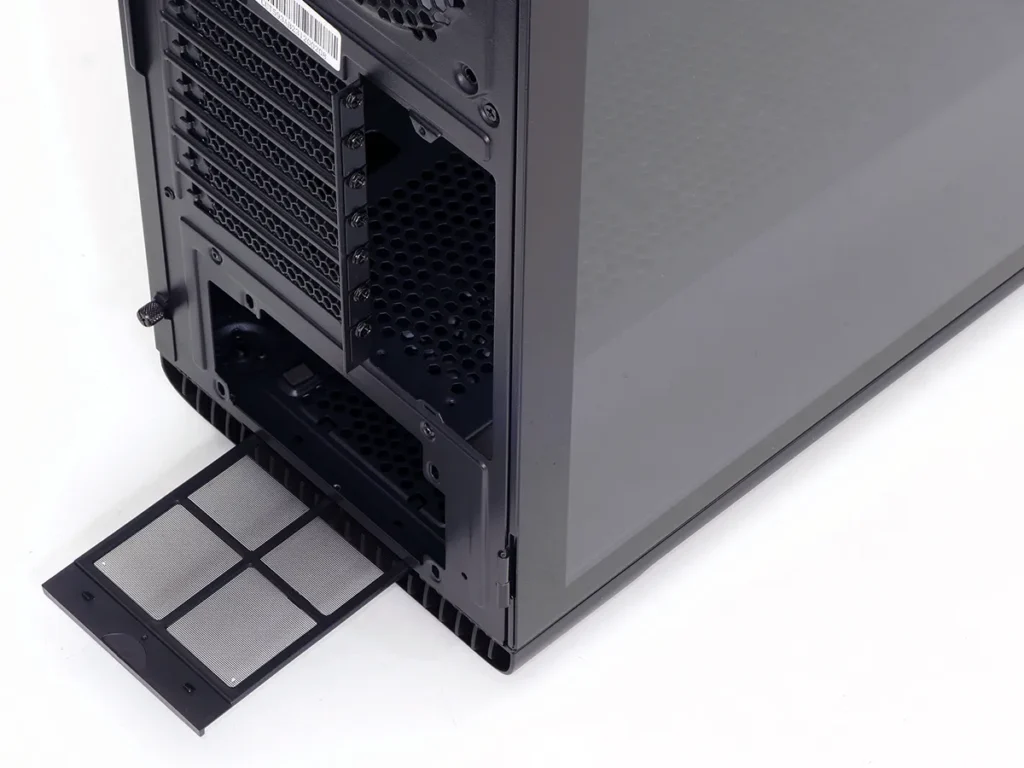
Regarding dust filters, the front’s filter is secured with two hooks at the bottom and four magnets at its sides and top. That probably means it’s washable since there aren’t any water prone surfaces to worry about, but we’d still rather use compressed air to clean it.
Though the top panel is a single piece, its filter is similarly encapsulated.

The great benefit of having a removable center section on the front panel is that its outer frame isn’t so easily removed, or even washable: It’s wired to the case. You might have to pull the frame off as shown to get better access to fan wires, but only if you’re replacing these fans with the parts from a liquid cooling kit. There’s just enough room behind them to place a 457mm-long (420mm format) radiator there.
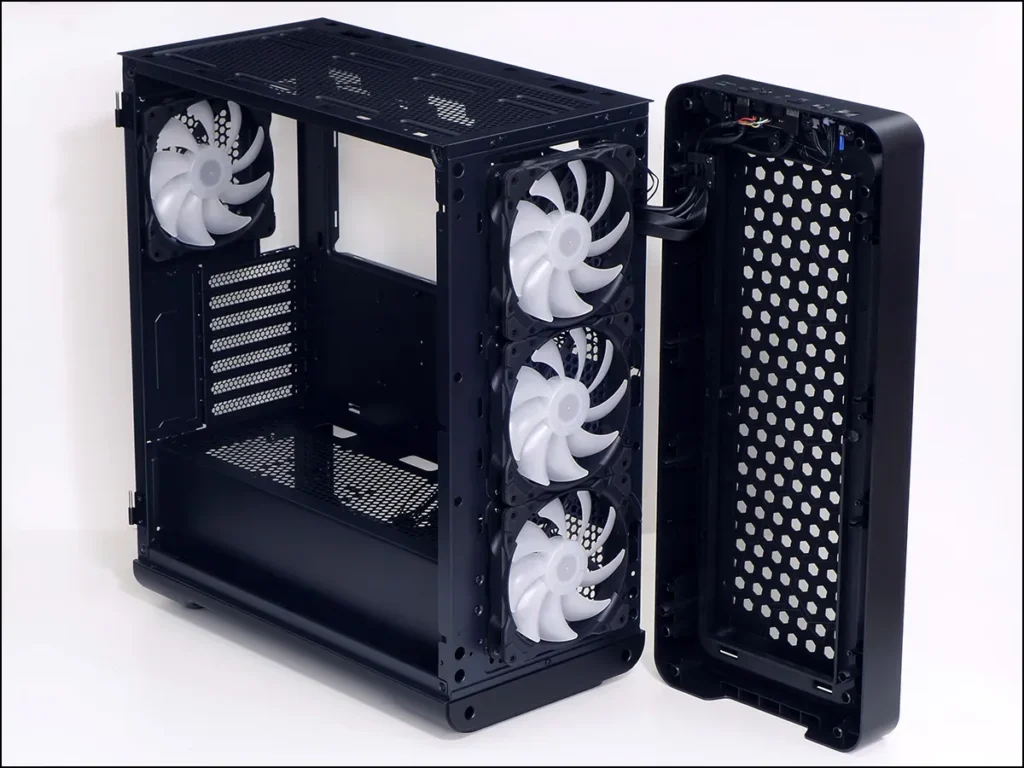
Looking at the space from the other direction, we find a 60mm-deep gap cut into the top of the power supply cover to enable long radiator placement. That doesn’t seem like much room to tilt the radiator into place though: We couldn’t fit a 38mm-thick by 457mm-long radiator into position, but it was close enough that we think that a 28mm-thick version might fit. Maybe. We’re going to recommend sticking to the 360mm radiator format until someone actually shows us a video of them inserting something larger.

Looking down the back, we see the 3x120mm/2x140mm fan mount on top that’s large enough to hold 52mm-thick cooler combos with radiators up to 422mm long, two removable drive trays on the back of the motherboard tray, and a small 3.5” drive cage inside the front of the power supply tunnel.

Looking a little more closely at the drive cage, we see that it has space for two 3.5” drives internally and holes on its lid to mount a third 3.5” drive. The motherboard tray has additional mounting holes for displaying two 2.5” drives on the opposite (window-facing) side.

Building With The CUT593
The CUT593 is EATX, but its hardware kit includes only three standoffs to add to the six that are factory mounted to the motherboard tray. Complicating things further is that if you’d like to add matching standoffs, the ones they use are metric (M3 threaded holes and 6mm length) but have #6-32 threads externally. This is a relatively common size in computer cases, but the mix of standards isn’t common outside of that special purpose.
The kit also includes four plastic stands, which are great for bracing boards that are too short to reach the next row of standoffs (such as Biostar’s recently reviewed B650MT) and, surprisingly, two Phillips to hex adapter sockets. We don’t know why the second adapter is there, we were just hoping to find three more standoffs.

Case cables include the button and indicator LED group, HD Audio to connect headphone and microphone jacks, a 19-pin Gen1 connector for the two USB3 Type A ports, and a Gen 2×2 cable for the USB3 Type-C port. Also included but not shown are a four-pin PWM fan cable that’s daisy chained to the other three fans, and an ARGB cable that’s also daisy-chained to the ARGB of the other three fans.

| System Configuration | |
| CPU | Intel Core i9-12900KF: 16C/24T, 3.2-5.2 GHz, 30 MB L3 Cache, LGA 1700 Fixed at 4.9GHz (P-cores, 3.7GHz E-cores) and 1.30V |
| CPU Cooler | Cooler Master MasterLiquid 240 Atmos closed-loop |
| Motherboard | Asus 660M Plus WiFi D4, BIOS 2402 (04/20/2023) |
| RAM | G.Skill TridentZ Neo DDR4-3600 C16, 2x 8GB |
| Graphics | Gigabyte GeForce RTX 2070 Gaming OC 8G: GeForce RTX 2070 1815 MHz GPU, GDDR6-14000, Maximum Fan |
| Hard Drives | Patriot Viper VPR400 1.0 TB M.2 SSD |
| Power | Cooler Master XG 750 Plus Platinum: Fully modular, 80Plus Platinum |
While we recently switched our test platform to fit a wider range of cases, its full-spec Micro ATX board still matches the 9.6” mounting depth of ATX: See the blue and yellow outlines in our installation image below that indicate the outline of 12” tall ATX and 13”-deep EATX motherboards, and also note that the two 2.5” drive mounts at the front of the motherboard tray are far enough forward to clear even the largest SSI-EEB variant of EATX.
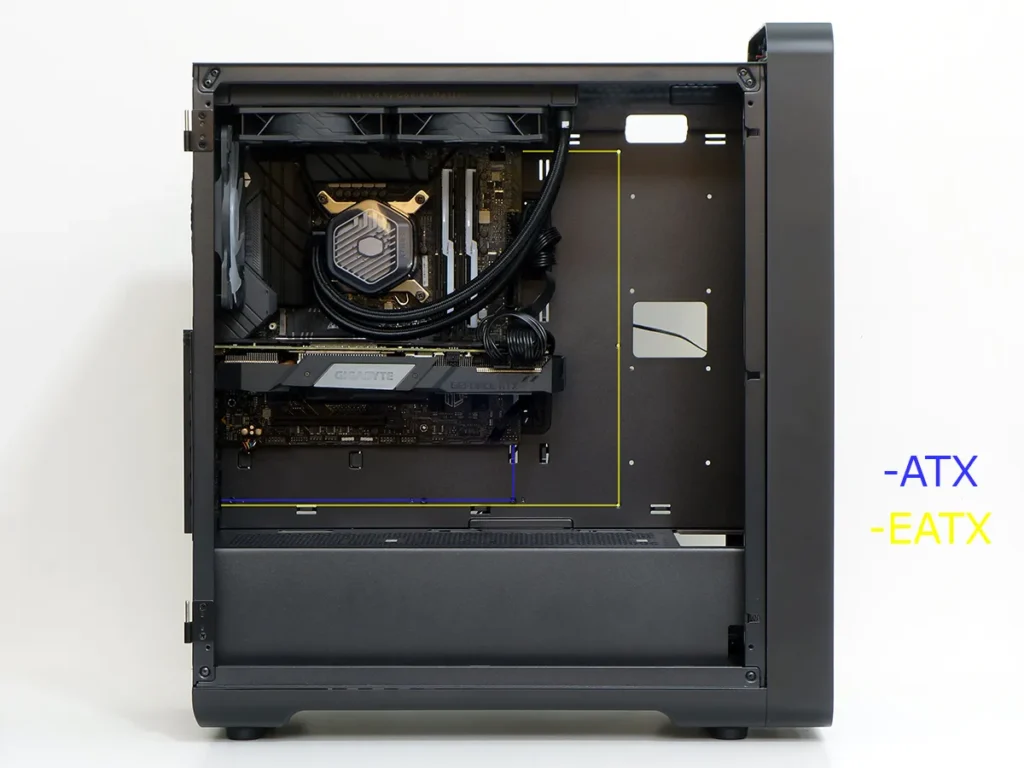
While the plastic outer panels aren’t elegant, the quality fit and consistency place the CUT593 well inside of the mid-priced performance market.
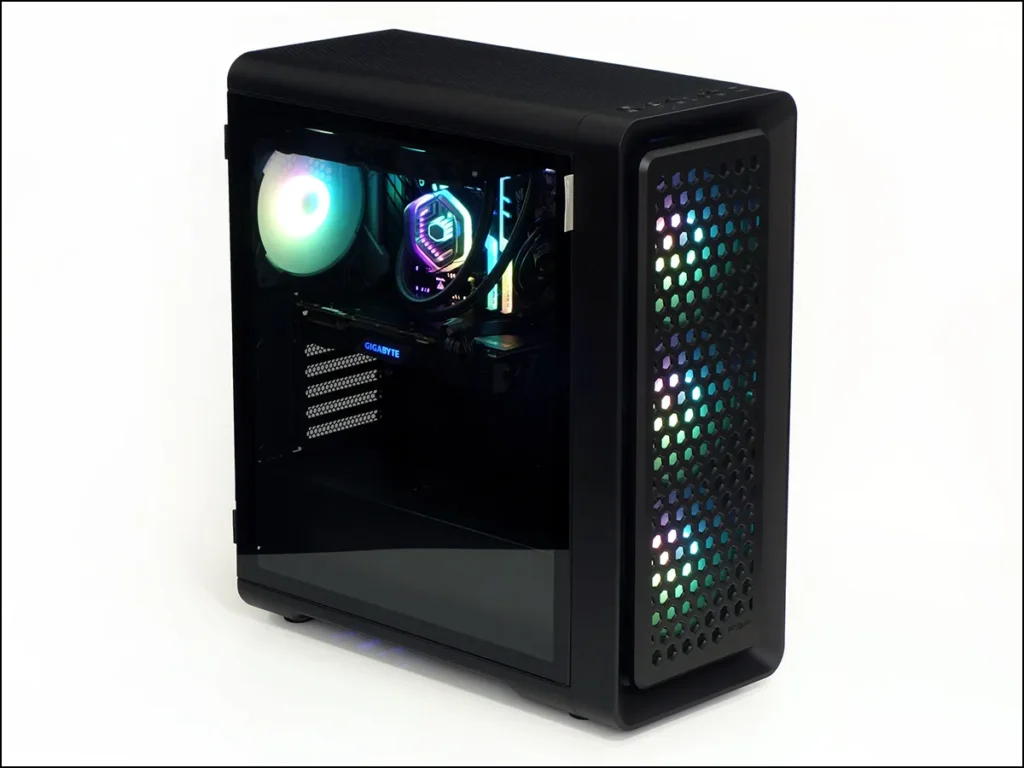
Test Results
We’re testing the ARGB (593A) version of the CUT593, and find that it while it comes out near the bottom of a tight pack in CPU cooling, the average temperature difference between it and the class-leading StarryKnight is only 3.33°. These two maintain similar separation when reading voltage regulator temperature, but the gap drops to around 1 to 2 degrees at the graphics card.

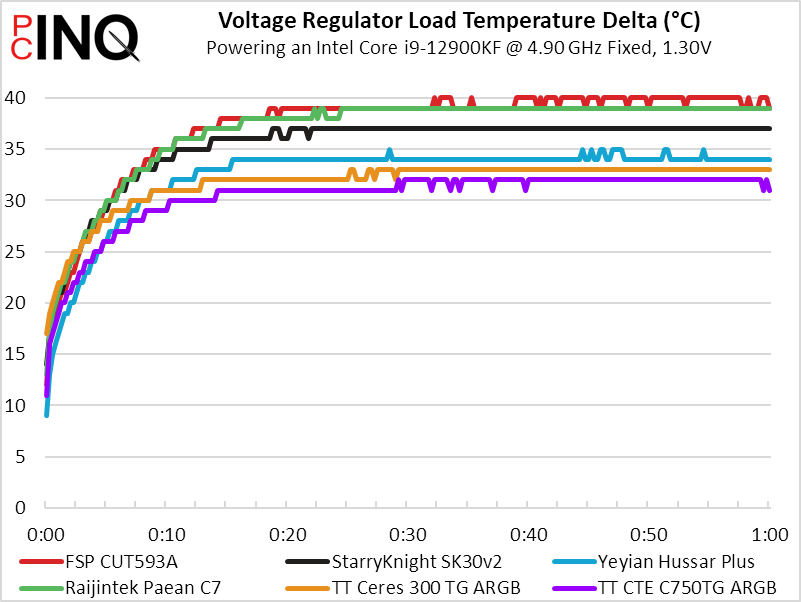

The CUT593A beats the SK30v2 by a large enough difference in noise that the two are virtually tied in cooling-to-noise ratio.

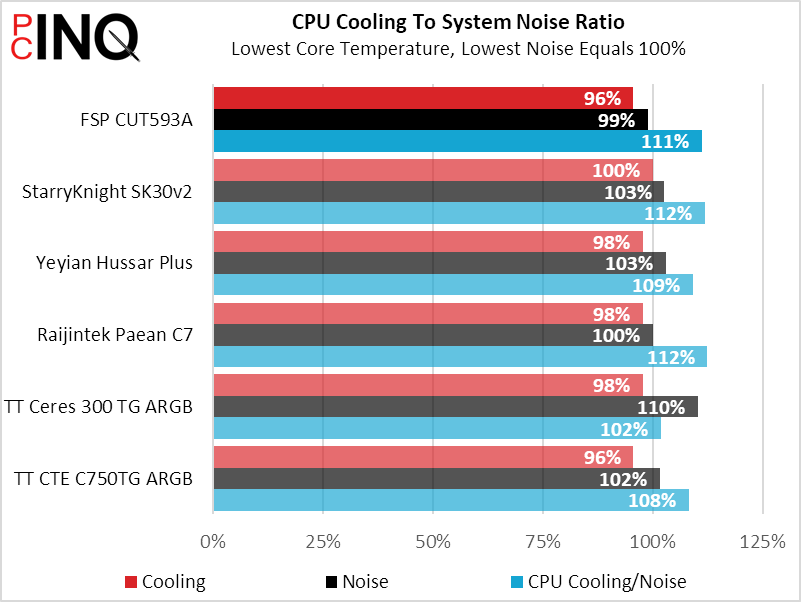
| FSP CUT593A | |
| Pros: | Cons: |
| Supports motherboards up to 13″ deep Supports dual 360mm-format radiators Includes three 140mm ARGB front fans Easily Accessed Dust Filters | Thin materials typical of price class Plastic appearance somewhat dated |
| The Verdict: | |
| The CUT593 steals value from the competing SK30v2 by providing better dust control. | |
If we have no other major complaints, we can at least point out that apart from the tempered glass left side, the plastic panels give the case a dated look of the 1990s. On the other hand, with superior dust control compared to its closest rival and a discounted price that also undercuts it, the CUT593 becomes a better-value choice for budget builders.

